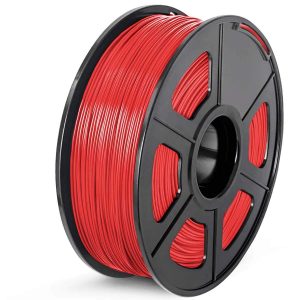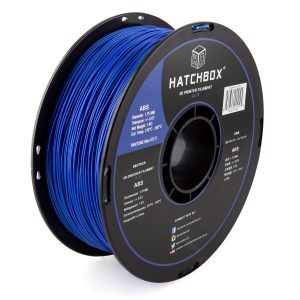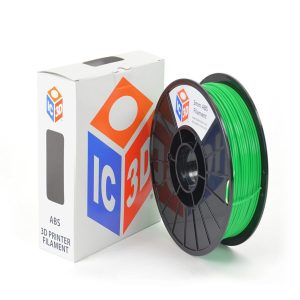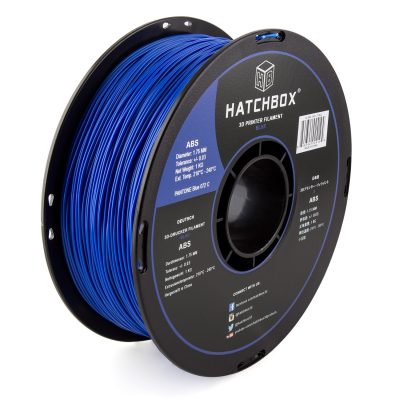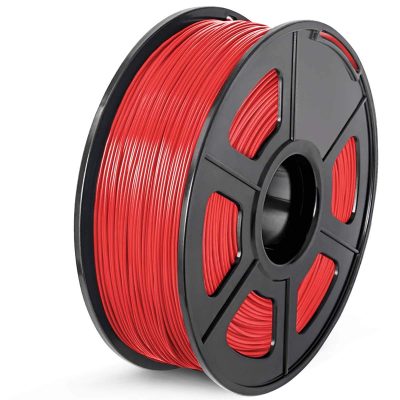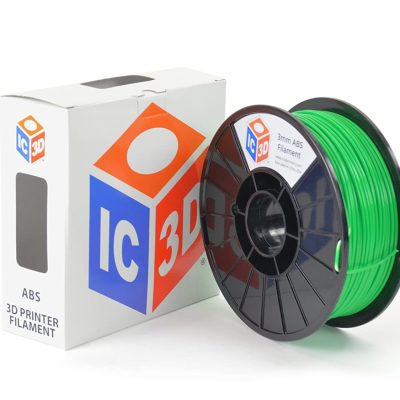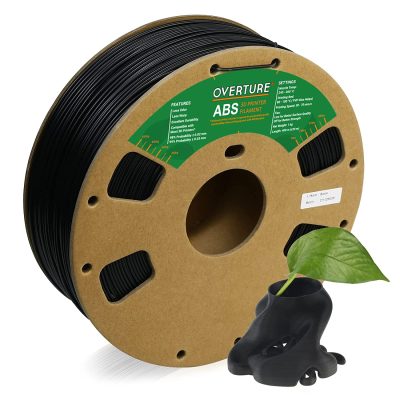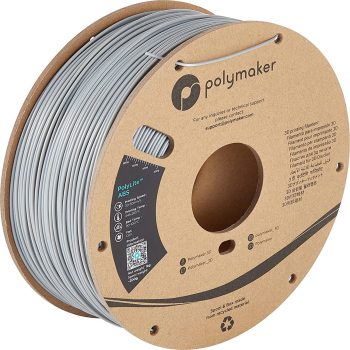- Last Updated: January 12, 2024
-
 Jackson O'Connell
Jackson O'Connell
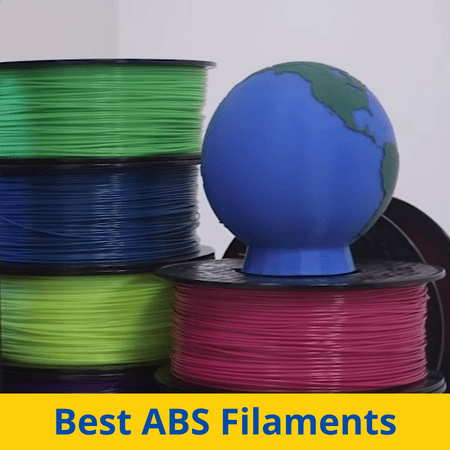 Tired of weak and brittle 3D prints? Maybe it’s time to switch to a different filament material… one like ABS!
Tired of weak and brittle 3D prints? Maybe it’s time to switch to a different filament material… one like ABS!
ABS filament is known for its superior strength over PLA, making it perfect for real-use 3D prints that require some durability. Plus, the material also offers other benefits, like slight flexibility, vapor smoothing compatibility, and more!
There are tons of ABS filaments you can choose from, but not all are worth your money. In this article, we’ll review the best ABS filaments for 3D printing, so read on!
Best ABS Filaments At A Glance
1. Hatchbox ABS (Best Choice)
2. Sunlu ABS (Best Value)
3. IC3D ABS (Premium Choice)
4. Overture ABS (Easy to Use)
5. Polymaker Polylite ABS (Quality Prints)
Our first ABS filament comes from Hatchbox, which is my personal favorite manufacturer of filament. Hatchbox ABS filament sits at about the market price, but it’s a lot easier to print than your regular ABS filament.
While it requires slightly higher-than-normal printing temperatures, Hatchbox ABS is super reliable. Of course, you still need an enclosure, but once you’ve tuned your slicer profile, you can expect consistently high-quality models throughout the entire spool.
I actually have fewer problems printing Hatchbox ABS than I do for most of my PLA filaments. But don’t take my word for it! Take the 8,000+ positive reviews that mention how overall amazing Hatchbox ABS is!
Additionally, the filament comes in a handful of different colors, like white, black, red, orange, hot pink, purple, and more!
So if you’re just starting out with ABS or want an easy-to-use and reliable option, definitely try out a spool of Hatchbox ABS!
Pros
- Good bang for your buck
- Prints are usually pretty strong
- Comes in a fair amount of different colors
- Very reliable
- Not too sensitive to print settings and the environment
Cons
- Some brittle prints here and there
- A bit hygroscopic
Now, if you’re looking for the best bang for your buck, look no further than Sunlu ABS. This filament costs over $5 less than your typical ABS material filament but performs better than $50+ spools. And while this price difference doesn’t sound so significant, if you print as much as I do, you’re burning through one or two spools per month, so it adds up quickly!
But the price isn’t the only reason I like Sunlu’s ABS filament. It’s known to have a dimensional tolerance of just +/- 0.02 mm, almost half the average for filaments (+/- 0.05 mm). With such high diameter accuracy, you’re not likely to run into extrusion issues from Sunlu’s ABS filament due to their precise manufacturing methods.
Additionally, I recommend Sunlu ABS for anyone trying to use ABS on a printer that has a subpar bed heater. That’s because the recommended bed temperature is just 85 °C, which is lower than most ABS filaments, meaning it’s compatible with more printers.
Sadly, this filament only comes in a few colors, including black, red, white, blue, and grey. But I feel Sunlu makes up for it with their lower-than-low prices, wide printer compatibility, and overall reliability, as indicated by the diameter accuracy and the many reviews for this filament.
Pros
- Super inexpensive and a great bang for your buck
- Good (low) diameter accuracy
- Reliable
- Low printing temperatures
Cons
- Limited color options
- Prints can be rather brittle
If you’ve got a pretty big 3D printing budget, then a) good for you for embracing your hobby and b) try some IC3D ABS filament.
IC3D produces some of the highest quality filament I’ve ever used, and their ABS options provide the holy trinity of filament: strength, printability, and good looks. Though it’s a bit more expensive than other options, its hundreds of good ratings (including mine) vouch for its excellence.
What surprised me most about this filament was how easy it was to post-process, and I can’t say that about all ABS filaments. Not only do prints made out of IC3D ABS dissolve well to acetone, but they also work really well with acrylic paints. Even the ones I bought at the dollar store!
So if you want an ABS filament that works well across all categories, then IC3D is my recommendation!
Pros
- Responds well to post-processing
- Pretty strong
- Decently easy to print
- Reliable
Cons
- Relatively expensive
- Limited color options
Overture is another filament brand you’ve probably seen while scrolling through the Amazon results of “ABS filament”.
I first started to dabble with Overture filament after I saw the low price on their PLA filament (which also is really good), but then got to love the brand more through their ABS option. At first glance, Overture ABS looks like just another “budget” filament option. But it’s also super easy to print, which is why I continue to use Overture on some of my printers.
And when I say “easy to print”, I don’t just mean only a few issues every now and then; I mean basically zero issues since using the filament. It doesn’t warp, isn’t brittle, doesn’t clog, and the four available colors somehow manage to make my ugliest designs look decent.
The only issue I’ve really had with Overture ABS is that it’s definitely a little more hygroscopic than other options. So, if your printer or filament stash is in a place near a sink or bathroom, consider also getting a filament storage container to keep your Overture filament dry.
But, other than that, Overture ABS is a filament I strongly suggest, especially for those who want a stress-free printing experience.
Pros
- Very easy to print
- Prints aren’t brittle
- Low price (good value)
Cons
- Hygroscopic
Lastly, Polymaker is another manufacturer of 3D printing filaments, from PLA to dissolvables (e.g. PVA) and nylon. PolyLite ABS is a great option for those interested in this material. Plus, it has a lot more to offer than just its attractive low price.
First off, PolyLite ABS is known for being easy to use.
This is especially true when it comes to print speed. While Polymaker officially recommends using a print speed between 30-50 mm/s (the standard for ABS), many reviews mention that you can use speeds around 80+ mm/s with still near-perfect results. I myself used 70 mm/s, 20 mm/s than my typical ABS print speed, and was absolutely fascinated by the detail preserved in the prints.
PolyLite ABS also is decently strong. Though it’s probably not the strongest of ABS filaments out there, it carries its weight, still massively outperforming PLA prints in tensile strength.
Of course, this higher-than-usual strength comes at the cost of a higher-than-normal recommended printing temperature of 245-265 °C. This limits which printers can handle PolyLite ABS, but if yours can, yay for you!
Finally, I can’t say goodbye to my review for PolyLite ABS without mentioning the vast color options. I’ve always been a fan of the filament colors offered by Polymaker, and they really nailed it with PolyLite ABS too. You can get the filament in 15 different colors, including every main color of the rainbow, black, white, teal, “Polymaker Teal”, and more!
So, if you want a low-price ABS material filament that’s high-quality overall, don’t forget about PolyLite ABS. It’s strong, fast, colorful, and so much more!
Pros
- Many color options
- Decently strong
- Can be printed very fast
- Low price
Cons
- Requires printing temperatures higher than the average for ABS
- Known to warp a fair amount
What is ABS Filament?
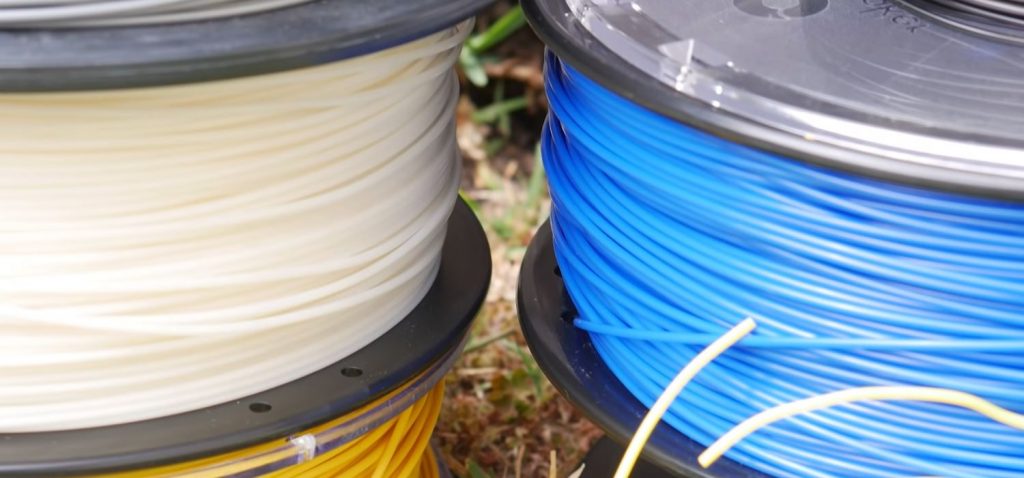
First off, ABS stands for Acrylonitrile Butadiene Styrene and is a thermoplastic sourced from processed oil. While it’s not the most environmentally-friendly material, its low-cost, strength, and other mechanical properties make it the perfect choice for manufacturers. That’s why it’s used for everything from LEGOs to car interior panels.
As for how ABS relates to 3D printing, it’s considered the 2nd most popular material for filaments, with PLA taking the 1st place spot. Your typical 1-kilogram spool of ABS filament costs under $25, and can be bought from basically any online retailer.
Unfortunately, ABS gets a bad rep in the community because it’s relatively difficult to print. Moreover, plastic is a lot more sensitive to environmental factors (e.g. ambient temperature) than PLA, so achieving high-quality models is more difficult.
When Should You Print with ABS?
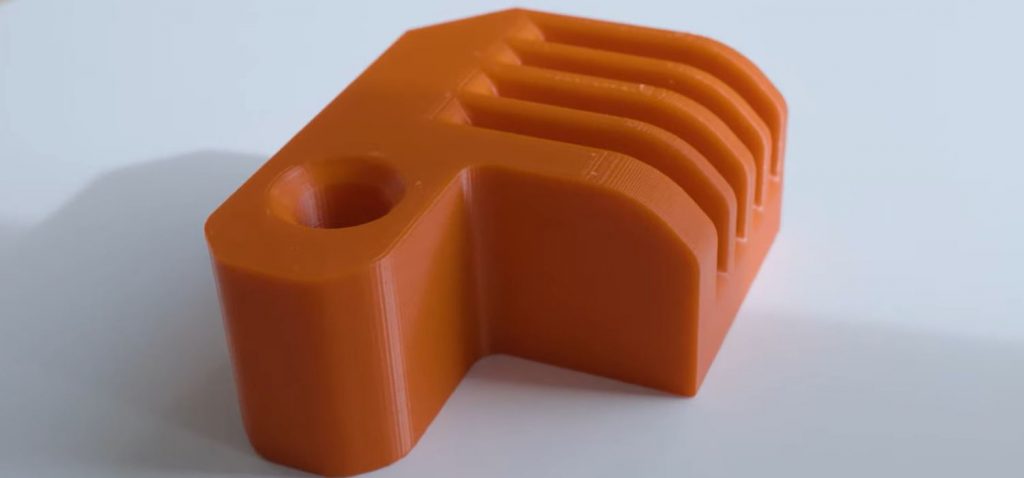
Although printing with ABS can make you hate your printer because it’s challenging to print, there are many times when the material is useful. Mainly, though, you should consider printing with ABS whenever strength is a factor for a print. For example, ABS is perfect for printing things like door hinges, gears, a phone case, or a monitor stand.
But ABS filament’s usefulness goes beyond just raw strength!
The material is also a lot more durable and resistant to the elements. While a PLA model will deform under the sun (UV light), prints in ABS filament will keep their shape in outdoors for years. I’ve literally had the same outdoor cup holder on my porch for two and a half years, and there aren’t any noticeable defects yet.
You also want to use ABS filament if you plan on layer smoothing your print, such as for cosplay items or display pieces. That’s because ABS plastic is soluble in acetone (nail polish remover), so you can use this chemical to dissolve the top layer of your print, achieving a shiny surface finish.
Check out our article on acetone vapor smoothing for ABS here to learn more.
Advantages and Disadvantages
Obviously, ABS filament has its ups and downs. We’ve compiled a list of the advantages and disadvantages of this filament material below to help you decide if ABS is for you!
Advantages
- Soluble in acetone so that you can layer smooth prints
- Slightly flexible, which makes it very durable
- Terrific mechanical properties, such as high strength, good resistance to UV light, waterproof, and resistance to high temperatures
- Inexpensive and widely available
Disadvantages
- Very difficult to print because the plastic is so sensitive to environmental factors, print settings, and more
- An enclosure and high-temperature heated bed are (basically) required
- Not environmentally friendly
- Considered toxic (not food safe)
How to Print Using ABS Filament?
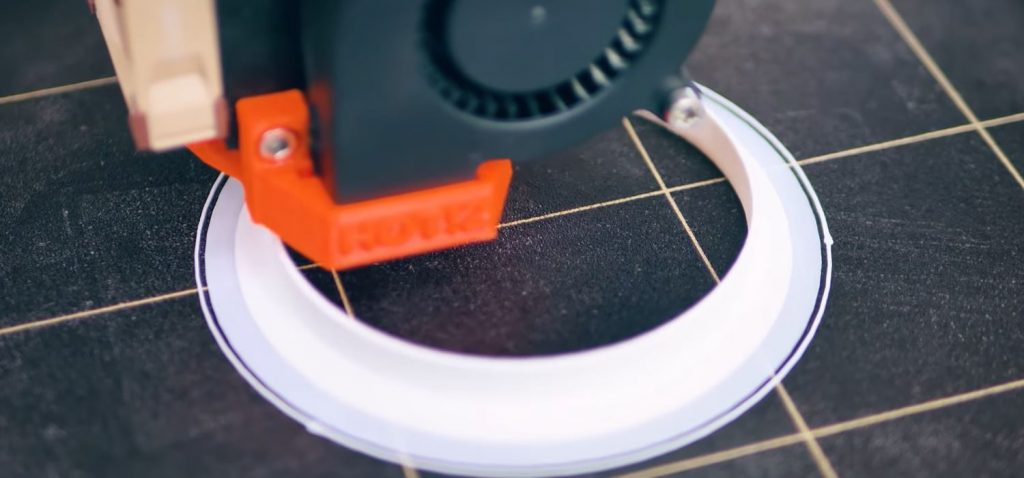
As we mentioned, printing ABS filament is pretty challenging, especially compared to PLA or PETG. But don’t let that scare you because, in this section, we’ve gone over exactly how you can print this type of filament.
First off, you’ll need an enclosure for your printer. An enclosure traps heat around your printer, ensuring that the ABS plastic has good layer-to-layer adhesion, resulting in stronger prints. An enclosure also keeps out air drafts (winds) to ensure high-quality prints.
Secondly, you’ll need to make sure that your nozzle and heated bed can reach the necessary printing temperatures. That would be around 240 °C and 100 °C, respectively.
If your printer can’t reach these temperatures, you’ll either need to use a different printer or upgrade the heating components on your current one. If you choose the former option, make sure to check out my guide to the best machines for printing ABS filament!
Third, you’ll need a well-tuned slicer profile. The exact slicer settings for printing ABS vary for everyone because every 3D printer is different. A raft or brim is recommended, though, as ABS is known for having issues with bed adhesion.
I recommend starting by using Cura’s default ABS profile for your printer (Dynamic or Regular quality), printing a test model, and adjusting individual settings based on the results. Do this until you achieve a level of quality that you’re okay with.
And that’s it! If you follow these steps, you should be printing high-quality ABS models in no time!
ABS vs. PLA
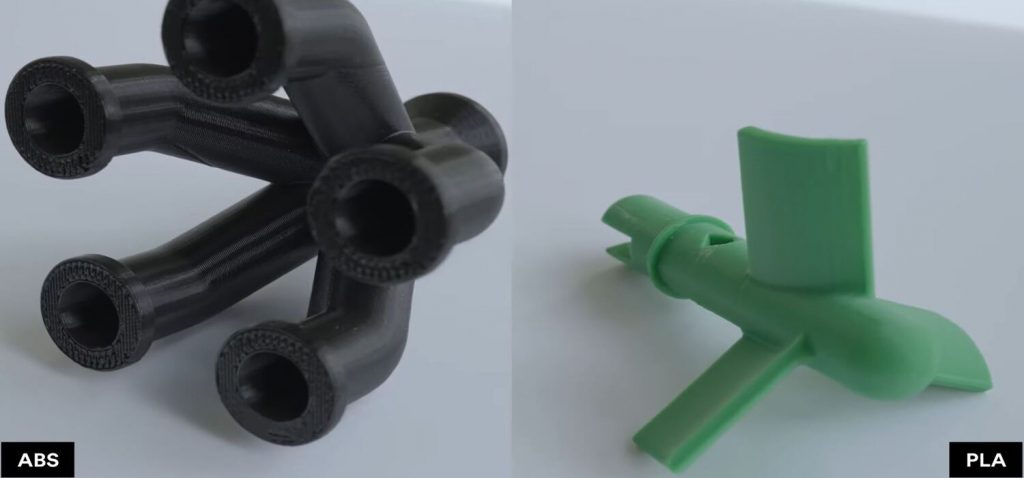
So how does ABS compare to its nemesis, PLA, the most popular 3D printing material? Well, there’s no clear winner, but there are a good bit of differences between the two.
ABS is a good bit stronger and less brittle than PLA, but PLA is a lot easier to print. That’s the main difference, but there are a few other small ones, like how PLA is more environmentally-friendly and slightly less expensive (by like $1) in most places.
But, overall, I’d say PLA is the better option for beginners and those who want a very stress-free printing experience. On the other hand, ABS is better for printing any part that needs to be strong, durable, or outside. It’s also the better filament material for multi-part assemblies because of its responsiveness to solvents like ABS.
Learn more about ABS vs. PLA here.
ABS vs. PETG
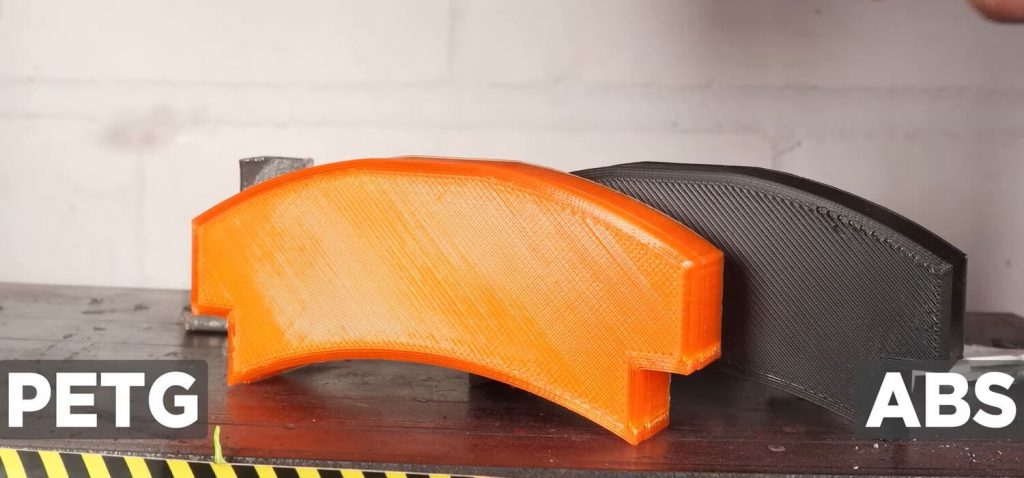
PETG is another popular filament material and is very similar (chemically) to the plastics used in water bottles and a lot of Tupperware. PETG is actually about just as strong as ABS and even more resistant to UV light.
However, ABS is less abrasive, meaning it won’t degrade your nozzle as fast. Additionally, it has a higher temperature resistance, so ABS parts can survive (without deforming) in hotter climates than PETG parts.
But it’s worth noting that PETG is a good bit easier to print than ABS and no enclosure is required. Sadly, if you’re printing PETG, your models are likely to have some stringing (makes prints look bad), which won’t happen with ABS.
So, if you want strong 3D prints but still want a pretty easy printing experience, PETG is definitely a material you should consider. However, ABS is the better choice for instances where you need that extra temperature resistance or don’t want to deal with stringing on models.
You can learn more about ABS vs. PETG here.
Is ABS Toxic to Print?
Our last bit of background information about ABS relates to its toxicity. Generally, people like to call ABS a toxic filament to print because it can release harmful carcinogens in the air when melted. However, don’t be too scared because, while you can usually smell the melted ABS nearby your printer, most of the fumes stay in your enclosure.
Conclusion
Whether you want to print stronger models or are looking to experiment with post-processing techniques, like layer smoothing, ABS is an excellent 3D printing material. While it’s a bit difficult to print compared to PLA, its strength and versatility prove useful in many scenarios.
But if you’re going to buy an ABS filament, don’t just click the first one you see. Instead, I’d recommend taking a look at Hatchbox or Sunlu’s ABS filaments. Both brands offer an amazing value for your dollar, are decently strong, and are considered reliable by many users.
However, if you want to take your ABS prints to the next level, then perhaps IC3D ABS is the one for you. If you’re willing to drop the extra $10-20 for this brand, you’ll get a whole lot better performance, like improved strength, ease of printing, and more!




